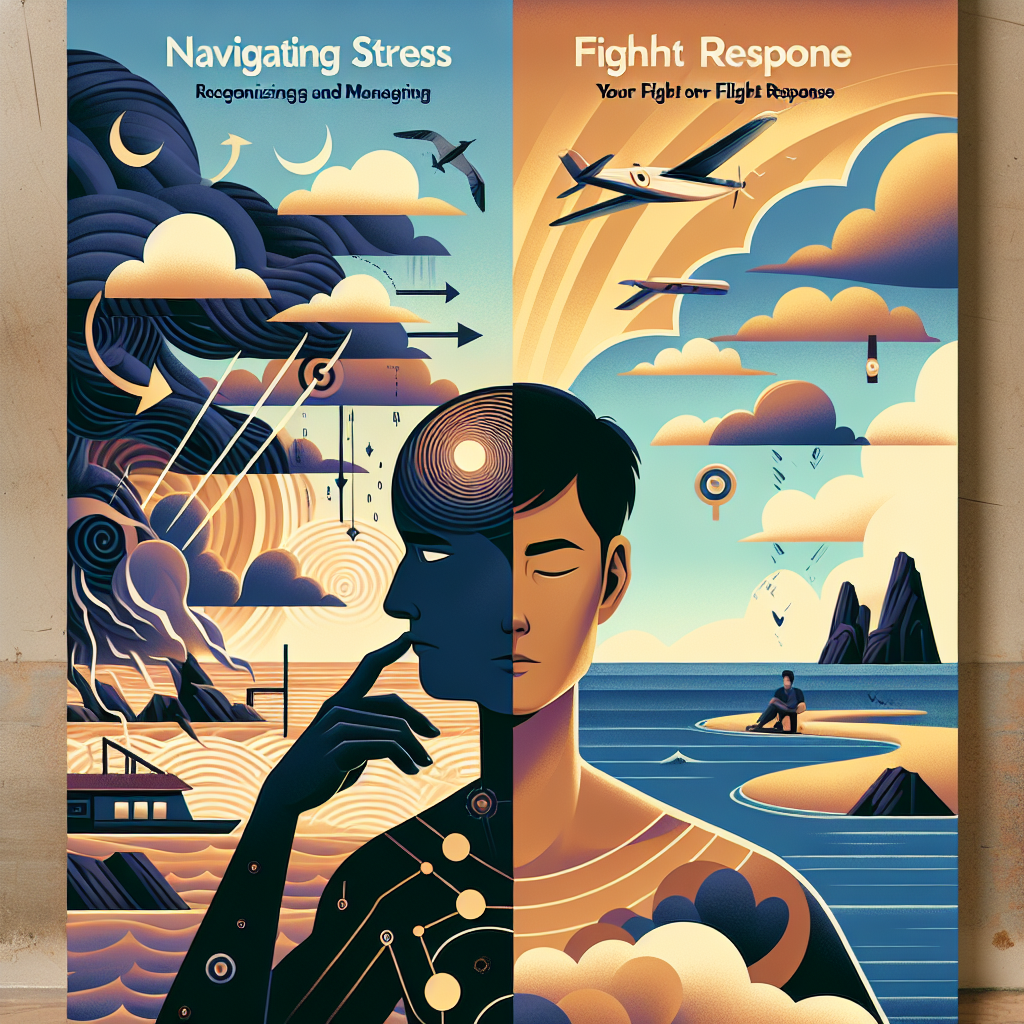
Navigating Stress: Recognizing and Managing Your Fight or Flight Response for a Resilient Life
Stress is a reality we all face, a universal aspect of human existence. However, navigating stress: recognizing and managing your fight or flight response can transform fear into empowerment, unlocking your potential to thrive even in adversity. This article delves deep into the intricate dance of biology and psychology behind stress responses, offering insights and strategies to equip you on your journey to resilience.
Introduction: The Tug of War Within
Imagine standing at a crossroads: one path leads to calm rationality, the other to a frenzied reaction guided by primal instincts. This internal conflict happens countless times every day. The fight or flight response is a fascinating yet often misunderstood mechanism that can significantly impact your mental and physical health. This reliance on instinct over reason can create a cycle of stress that feels unbreakable. However, by learning to recognize and manage your fight or flight response, you can reclaim your narrative and effectively navigate through life’s challenges.
Understanding this biological response, coined by physiologist Walter Cannon in the early 20th century, is crucial for anyone wanting to progress in personal and professional realms. When stress triggers this automatic mechanism, the body prepares itself for danger, leading to physiological changes like increased heart rate, rapid breathing, and enhanced physical abilities. But how can we harness this response rather than let it govern our lives? Let’s explore the intricacies of this complex cycle.
The Science Behind Stress: What Is Your Fight or Flight Response?
The Mechanism of Stress
When faced with a threat, real or perceived, the brain triggers an immediate response. The hypothalamus activates the adrenal medulla, leading to the release of adrenaline and noradrenaline. This surge of hormones prepares the body to react swiftly—heart rate increases, blood flow shifts, and energy surges in preparation to confront or escape danger.
Table 1: The Phases of the Fight or Flight Response
| Phase | Description |
|---|---|
| Perception of Threat | The brain detects stressors, initiating the response. |
| Hormonal Surge | Adrenaline and cortisol flood the body for quick reactions. |
| Physical Changes | Heart rate increases, muscles tense, and senses sharpen. |
| Action Taken | Either fight through confrontation or escape for safety. |
Through understanding this biological response, we can better manage our reactions when stress arises, allowing for more measured and constructive outcomes.
Stress in Everyday Life
Everyday stressors—from a looming work deadline to the pressures of parenting—can trigger this response, sometimes leading to chronic stress. Chronic stress can manifest in various ways, negatively impacting our lives and relationships. Recognizing these stressors is the first step in navigating this complex emotional landscape.
Case Study: Julia’s Journey
Consider Julia, a 32-year-old marketing manager facing significant workplace pressures. Initially, Julia experienced constant anxiety, unable to separate work from her personal life. Her fight or flight response was triggered at the slightest critique from her boss, leading to overreactions that affected her job performance and health.
By recognizing her triggers and utilizing deep-breathing techniques to manage her physiological reactions, Julia transformed her experience. This journey of self-awareness and coping strategies not only improved her work life but enriched her relationships outside of work as well. Your understanding of your fight or flight response could follow a path similar to Julia’s when you commit to learning and practicing self-regulation.
The Psychological Impact of Stress
How Stress Affects Mental Health
Emotions associated with the fight or flight response—fear, anxiety, and anger—can overwhelm rational thought. The constant state of being “wired” leads some to develop anxiety disorders or to perceive threats where none exist. Moreover, chronic stress can lead to burnout, which impacts not only mental health but also physical well-being.
Table 2: Signs of Chronic Stress
| Sign | Description |
|---|---|
| Emotional Changes | Increased irritability, mood swings, or withdrawal. |
| Physical Symptoms | Headaches, fatigue, or digestive issues. |
| Cognitive Impact | Memory problems, indecisiveness, or reduced focus. |
| Behavioral Shifts | Changes in sleeping patterns, appetite, or substance use. |
Case Study: Mark’s Transformation
Mark, a software engineer in his 40s, confronted persistent migraines spurred by work-related stress. After persistent consultations with healthcare professionals, he learned to recognize signs of impending stress and created a personal strategy for managing his fight or flight response. Through mindfulness techniques and scheduling regular breaks during the workday, Mark effectively curtailed stress and improved his overall health. As Mark’s physical symptoms lessened, he regained mental clarity, crucial for his profession, allowing him to excel at his job.
Strategies for Managing Your Fight or Flight Response
1. Mindfulness and Meditation
Mindfulness practices such as meditation can significantly help in navigating stress: recognizing and managing your fight or flight response. Research shows that regular mindfulness practice reduces anxiety and stress hormones, aiding in emotional regulation and enhancing overall well-being.
2. Breathing Techniques
Simple breathing exercises can be highly effective in countering the physiological effects of the fight or flight response. Techniques such as box breathing or 4-7-8 breathing can help slow your heart rate and induce a state of calm.
Box Breathing Technique
- Inhale through the nose for 4 seconds.
- Hold your breath for 4 seconds.
- Exhale through the mouth for 4 seconds.
- Hold for another 4 seconds.
3. Physical Activity
Engaging in regular physical exercise helps manage stress by releasing endorphins and reducing stress hormones. Activities such as yoga, running, and even walking can be beneficial in regulating your fight or flight response.
4. Healthy Sleep Habits
Adequate sleep is essential for effective stress management. Creating a sleeping environment conducive to rest and establishing a consistent sleep schedule can reinforce your body’s ability to handle stress.
Case Study: Sarah’s Success
Sarah, a 28-year-old teacher, found herself overwhelmed with daily responsibilities and began turning to unhealthy habits. Recognizing the detrimental effect of her fight or flight response, she incorporated physical activity into her routine—cycling three times a week and practicing sleep hygiene. In her case, breaking the cycle of stress allowed her to thrive both personally and professionally.
Emotional Regulation Strategies
Recognizing Triggers
Proactively identifying what situations trigger your fight or flight response is crucial. Keep a journal tracking your emotional states and responses to stress.
Reframing Thoughts
Cognitive-behavioral strategies encourage reframing negative thought patterns. For example, instead of thinking, “I’ll never finish this project”, try “I can break this project into manageable steps.”
Seeking Professional Help
If stress becomes overwhelming, seeking support from a mental health professional is a vital step. Therapists can guide you through coping strategies that facilitate your journey in navigating stress: recognizing and managing your fight or flight response.
Conclusion: Embrace the Journey
Navigating stress: recognizing and managing your fight or flight response is no easy task, but it is undoubtedly a vital one. The insights uncovered in this article illuminate a path toward resilience. Each of us has the opportunity to turn stress into a stepping stone rather than an obstacle.
Think of stress management not as a destination, but as an ongoing journey filled with choices. By incorporating the techniques discussed and learning from experiences like those of Julia, Mark, and Sarah, you can redefine your relationship with stress.
Motivational Takeaway
Your response to stress shapes your narrative. Choose empowerment. Celebrate each small victory along the way. Remember, navigating stress is an essential life skill that adds to your resilience and personal growth. Embrace the power you have to conquer your challenges with grace.
FAQs
What triggers the fight or flight response?
- The fight or flight response can be triggered by both real and perceived threats. Common stressors include deadlines, personal conflicts, and significant life changes.
How do I know if I’m experiencing chronic stress?
- Symptoms such as persistent fatigue, frequent headaches, irritability, and sleep disturbances may indicate chronic stress. It’s essential to monitor how you feel regularly.
Can children experience the fight or flight response?
- Yes, children can experience the fight or flight response. They may react to school pressures, family issues, or bullying symptoms similar to adults.
Are there any long-term effects of prolonged stress?
- Yes, prolonged stress can lead to various health issues, including cardiovascular disease, anxiety disorders, and weakened immune responses.
- How long does it take to see results from stress management techniques?
- The timeframe varies from person to person, but individuals often begin to notice improvements within a few weeks of consistent practice with stress management techniques.
By implementing the lessons from this article, you can begin your journey towards not just surviving stress but thriving in its midst.

















